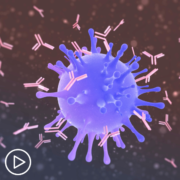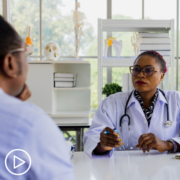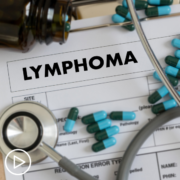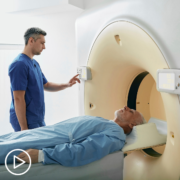PODCAST: HCP Roundtable: Critical Clinical Trial Conversations in the Expanding Myeloma Landscape
Treatment options for multiple myeloma have increased substantially, mainly attributed to advancements in clinical trials. More than ever, HCPs having conversations about trials is critical. Given that underrepresented communities bear a disproportionate burden of multiple myeloma, it becomes imperative to shift this paradigm.
What are the optimal approaches to initiate these conversations early in the patient journey? How should HCPs effectively communicate information about clinical trials to patients and their families, including care partners? Myeloma experts Dr. Craig Cole and Charise Gleason lend their expertise, offering insights into best practices and guidance on the next steps to be taken.
Download Resource Guide | Descargar guía de recursos
Transcript:
Dr. Nicole Rochester:
Welcome to this Empowering Providers to Empower Patients Program. I’m Dr. Nicole Rochester, founder and CEO of Your GPS Doc. EPEP is a patient empowerment network program that serves as a secure space for healthcare providers to learn techniques for improving patient-physician communication and overcome practice barriers. In this
Myeloma roundtable, we are tackling critical clinical trial conversations in the expanding myeloma landscape. Some of the things we’ll discuss during this program include, how to explain the sequence of myeloma treatment and how clinical trials fit in. Healthcare provider to healthcare provider, recommended strategies for initiating clinical trial conversations early in the myeloma patient journey, and how to effectively mitigate and manage concerns regarding clinical trials through education, and continuously encourage patients and their care partners to ask questions.
It is my honor and privilege to be joined by Charise Gleason, vice President and Chief Advanced Practice Officer for Emory Healthcare, and adjunct faculty at the Nell Hodgson Woodruff School of Nursing at Emory University. Ms. Gleason leads the physician assistants and nurse practitioners across Emory Healthcare, overseeing clinical practice, quality, safety, and education. Thank you so much for joining us today, Ms. Gleason.
Charise Gleason:
Thank you so much for having me.
Dr. Nicole Rochester:
We’re also joined by Dr. Craig Cole, a board certified hematologist. Dr. Cole leads multiple clinical trials in multiple myeloma, and has worked extensively with patient advocacy groups to empower, educate, and bring equitable care to everyone. Thank you so much for joining us today, Dr. Cole.
Dr. Craig Cole:
Yeah, and thank you for the invitation.
Dr. Nicole Rochester:
While this conversation can be broadly beneficial, in this program, we are speaking to the unique needs of myeloma patients and families. So let’s get started with how to explain the sequence of myeloma treatment, and how available clinical trials fit in. So I’m going to start with you, Dr. Cole. We know that there has been rapid advancement in the myeloma sphere. Can you speak to how the introduction of novel drugs, treatment combinations and therapeutic modalities may pose some challenges for healthcare providers as they attempt to explain the sequence of treatment in relation to available clinical trials?
Dr. Craig Cole:
Yeah, that’s a really good question, especially because so many things have been changing in myeloma, and such a rapid secession. It really, it’s been kind of not only an incredible transformative past 20 years in myeloma as we’ve moved away from using chemotherapy to using really targeted therapy, but really in the past five to 10 years, and us using immunotherapy and now T-cell directed therapy, it’s been transformative.
And it’s been very, very difficult for myeloma experts to kind of configure how these treatments are sequenced, and how the clinical trials are conducted. But basically, we have gone from using single drug therapies to using combination therapies for refractory patients to using multiple modalities and as upfront therapy for myeloma. Up until today, us using four-drug induction therapies with IMiDs proteasome inhibitors and now immunotherapy with anti-CD38 therapy being used upfront.
Now, we have…we’re on the fact we are past the horizon of using T-cell directed therapy for relapsed/refractory myeloma. Those are now being put in combinations. And at the last meetings, we saw data in combining talquetamab with the bispecific antibody with pomalidomide (Pomalyst) having incredible response rates to 99 percent to a 100 percent. The combination of using daratumumab (Darzalex)with teclistamab (Tecvidli) at ASCO a couple of years ago having very, very, very high response rates for relapsed/refractory patients.
And, of course, the combination of using two bispecific antibodies talquetamab (Talvey) and teclistamab together having, again, in these incredible response rates and for relapse refractory myeloma. So in very quick orders, we’re going to see those therapies moving further and further upfront, which is a huge benefit to patients.
But it can be kind of difficult to keep up with all the changes in myeloma, especially as we move from using these drugs as single agents, to using them in combination. And not only to speak to using some of the newer drugs like Mezigdomide in combination with daratumumab, having one of the CELMoDs having very, very high response rates.
And so it’s exciting, but it does, it’s a challenge to discuss clinical trials with patients, because so many things have changed. We now have clinical trials across the spectrum of myeloma, using bispecifics as upfront and smoldering myeloma, which was at the last ASH meeting to using again, more novel therapies upfront and relapsed/refractory space and in the maintenance therapy space.
Dr. Nicole Rochester:
Well, that’s all very exciting, and I appreciate you sharing that because as you’ve said, there’s been a really kind of an explosion for lack of a better word, in the numbers of treatments that are available as well as increasing improvements and results. But as you shared, having all of these different modalities available can definitely cause some confusion even among those who do this every day. Do you have anything to add to that, Ms. Gleason?
Charise Gleason:
No, I think, well, I think Dr. Cole described that perfectly. It’s an exciting time, and also a challenging time, which just really brings you back to that team care approach to your patient, and how all of us need to work hard to keep up to date on the latest information. Dr. Cole mentioned quadruplet therapy, and we’ve got two clinical trials that have essentially told us. if you add that quadruple therapy and add that antibody upfront, you drive that deeper response.
So we change our practice probably sooner in the academic settings. And it’s really how do we get this out to other healthcare providers in our referral basis that send patients to us? And then also, how do we do maintenance? And I think Dr. Cole would agree most of us risk-stratify for that maintenance setting too, whether it’s one drug or multi-drug, depending on our patient’s disease.
Dr. Nicole Rochester:
Wonderful. So certainly, this conversation alludes to the fact that the clinical trials regarding these medications are also increasingly complex. And so I’m going to go to you, Ms. Gleason, because we know that nurses and advanced practice providers provide understanding of these trials, including potential benefits and risks, and all of the things that are required as they consider participating in a trial. And then, as you all have both shared, there is some tailoring around the treatment with regard to the disease state, whether it’s relapsing, whether it’s refractory. So with that in mind, do you have any best practices around tailoring the trial conversation with regard to specific patient needs and situations?
Charise Gleason:
Well, I’ll start with, we bring that discussion with all of our patients about the potential of a clinical trial from the start. And so we’re all versed on that, we all look to what clinical trial could be available for this patient. So we’re used to having that conversation. So our teams all need to be educated, participate in our research meetings, so we are ready to discuss a trial on that. We sometimes get to spend more time with patients, and we get to know our patients. These are patients we see frequently, and so we can have those conversations.
You might have somebody who’s starting to have a biochemical progression. It’s not time to change their therapy yet, but we’re already thinking about what’s that next line of therapy. And so as we start to approach that with clinical trials and standard of care, and opening that dialogue, so it’s really that communication and that rapport and relationship you have with your patient, and that care partner. So an ongoing conversation about the different treatments that are available to them.
Dr. Nicole Rochester:
So we know that patients with myeloma are living longer lives based on everything that you all have shared, and with that comes a different set of options and challenges. And you also have alluded to this team-based approach, Ms. Gleason, and we know that there’s a critical role that advanced practice providers play in the myeloma clinical trial setting. So I’d love for you to speak to that..the role that advanced practice providers play in myeloma clinical trials.
Charise Gleason:
Yeah, the advanced practice providers have started specializing like our physicians do, and we have that collaborative relationship, and we are part of that team approach to take care of our patients. So we’re identifying patients for potential clinical trials. Our scope of practice does vary a little bit from state to state. So in some cases, we can also enroll patients. If we’re not able to do that, though, we can already have discussed the trial, discussed side effects, presented them with the consent. So when they do meet with the physician, they’ve already seen a lot of that information, and then they can ask further questions with the physician.
I think the other big role that we play in the clinic setting is we see these patients, we see these patients for follow-up. So we’re doing a lot of management of the side effects, supportive care through the trials. We might be a little more available during the week, so if a patient’s here on another day, and they’ve got something going on, we’re answering those portal questions, and calling patients back and just really collaborating with our physicians and also the research team.
Dr. Nicole Rochester:
Dr. Cole, I’m going to turn the conversation back to you. As a physician, I know that often, there are some barriers just as part of our everyday practice that can hinder our work. And so I’d love for you to speak to any unforeseen or outdated practice related barriers that you feel may hinder your work, and the work of your colleagues specifically as it relates to myeloma trials. And then if you could also share some potential solutions to those barriers.
Dr. Craig Cole:
Yes, super good question. I love this question. There are a lot that are out there that I…barriers that I hear providers talk about at other academic centers and in the community. One is that patients don’t want to go on clinical trials that they…and some of that is subconscious bias. Sometimes those are true, true bias. We know the FDA knows all the drug companies all, and I think every myeloma provider knows that there have been horrific disparities in the enrollment of patients in clinical trials based on race and age and ethnicity that the FDA looked at some of the data of trials that were going for FDA approval, and found that over the past 10 years, and that in those trials, that only 4 percent of the population of the trials were Black.
While in the United States, the number of Black myeloma patients is about 20 percent, over 20 percent of the myeloma population. So that’s a huge disparity. And what I hear is that while older patients and Black and Hispanic and Asian patients don’t want to go on clinical trials, and that’s not true. That’s been shown in multiple clinical trials that actually, the patients of different ethnicities and races actually are more likely to go on clinical trials than other racial groups. And so I think that it’s really important to keep that in mind that patients really…that really the ownership of getting a patient on a clinical trial is really on us to present the clinical trial option to them with every single conversation that we have.
Some of the other barriers to clinical trials is, and Ms. Gleason had mentioned this, what they do at through the Emory system is that, well, the nurses and the other staff in the cancer center aren’t aware of the clinical trials, that when a patient goes through the clinic, they talk to more than just the provider. They talk to the treatment nurses, they talk to the intake people, they talked to the MAs, they talked to the scheduling people.
And there was a study that was done a few years ago in looking at patients who were given consent forms and declined clinical trials. And they found that a lot of patients declined clinical trials, well, because they said that, well, their doctor didn’t want them on the trial. And when they looked further into that, they saw that, well, the doctor offered them a clinical trial, but when they discussed the clinical trial with a nurse practitioner, when they discussed that trial with a treatment nurse or the MA or any of the other staff, when they didn’t know about the clinical trial, that was considered well, if you don’t know about the clinical trial, it must not be good for me. And then they withdrew from the trial.
So just like what they do, what Ms. Gleason had said, we have an all-in approach. We make sure that the treatment nurses, the MAs, the intake people know what we’re doing, know about our clinical trials, because that’s the fun part about what we do. The fun part is when we say, look, my goodness, this four-drug therapy had a 100 percent response rate. That shouldn’t be left in the physician compartment. It really shouldn’t be left in the provider compartment. That excitement should be clinic-wide. And when you have that all-in approach where everybody’s involved, everyone’s excited about clinical trials, it produces a culture of clinical trials that everybody wants to be part of, and the patients then can jump on that bus and feel comfortable participating in the trial.
Dr. Nicole Rochester:
Wow. Thank you for elucidating that. Both the issue of the health disparities that we see in clinical trials and the need to diversify that clinical trial patient population, some of those biases that exist, as well as really lifting up this idea of creating a culture of clinical trials. I love the language that you use for that and the idea that everyone throughout the entire clinical encounter needs to be both aware of, and excited about the clinical trials that are underway. So I appreciate that.
That leads us nicely into our next segment, which is really focusing on strategies for fellow healthcare providers for initiating clinical trial conversations early in the myeloma patient journey. So I’m going to go back to you, Ms. Gleason. We’ve been talking about this team-based approach. We know that nurses serve as key coordinators of care in the myeloma trial setting, as well as other members of the healthcare team. So from your perspective, what are some recommended strategies that you can share to encourage advanced practice providers, specifically how to initiate the clinical trial conversation at the outset of care?
Charise Gleason:
First, we need to educate our advanced practice providers. So for new APPs coming into our system, part of their onboarding is the research mission, exposing them to the clinical trials, exposing them to what we have available. We have a weekly research meeting, I’m sure Dr. Cole has similar practices. And then our group has a separate meeting once a week, where we meet for two hours. The myeloma team, we have APPs who are off that day who call in for this meeting, because we go over our patients, we talk about what’s, clinical trials are available, that’s just how we practice and we think about that.
I would like to add to that, referring to a center early is so essential as well, and for us to start having that conversation. And I’ll talk a little bit to build on something Dr. Cole said with our patient population. In Atlanta, in our database, 40 percent of our data is based on Black patients. And we enroll about 32% to 33% of Black patients on clinical trials. And what our work on trials has showed us too, if you give the same access to every patient, you have good outcomes and good outcomes for Black patients, if not better, than white patients. So we all need to be versed on that, whether you’re the research nurse, the clinic nurse, the physician, the advanced practice. And so we really do bring that approach to taking care of our patients.
And then, managing those side effects and having that open dialogue. So patients aren’t surprised by things. And I’ll use talquetamab for instance. We have a patient who is still on the original trial, who relapsed on a BCMA targeted therapy. Early on, these side effects were new to everybody. And she wanted to come off the trial month end. And it was that education piece and working with her, holding the drug, that now almost two years later, she’s still in remission, tolerating the drug. And so those are the stories and these are the experiences we have. We’re giving really good drugs on clinical trials and patients are responding well.
Dr. Nicole Rochester:
That’s an amazing success story. Thank you for sharing that. What about you, Dr. Cole, with regard to potential strategies for healthcare providers, what are some things that they can implement for initiating these clinical trial conversations early in the journey, particularly in the current environment?
Dr. Craig Cole:
Yeah. And Ms. Gleason had mentioned this at kind of the top of our talk about having those conversations on day one. On day one of our patients coming in either as a second opinion, as a new diagnosis, as in whatever setting, we talk about…we have a list that we go through with the patient that talks about their stage or the disease, how we’re going to follow up. And there’s a line that I have to address, which is, clinical trials. So I mentioned our clinical trials, I mentioned on day one. And I think one strategy that other healthcare providers can take is that, even if you don’t have a clinical trial at that time, so right at this moment, we don’t have an upfront clinical trial.
We have one for maintenance therapy, post-transplant, but we don’t have an upfront trial. I mention that. I say that there are clinical trials that are available for your myeloma. Right now we don’t have a clinical trial for upfront myeloma, but we can refer you for a second opinion for an upfront trial if you’re interested or…and we have a clinical trial in maintenance. So that sets the groundwork that we’re going to talk about clinical trials on every visit. And that it doesn’t come as a surprise. Because the last thing you want to do is that someone is having a relapse and you say, “Oh, we’re going to talk about clinical trials today.” Because then it’s like, “Oh my goodness, this is a desperation.” This is a desperation move, and it puts a lot of anxiety when you frame it, and we need to do this now as opposed to having on day one.
The second thing that I think really helps is getting patients involved in the myeloma community, especially with the support groups having not only the patients, but their care providers and families involved in the myeloma community. Because the myeloma communities through a lot of the support agencies like the IMF, the MMRF, the HealthTree, they have a very strong clinical trial culture. And when patients get involved, not only is that empowering to see other myeloma patients doing well, but to hear other myeloma patients talk about their experiences in clinical trials really, really helps. And I think the last thing that we use to help patients, go through clinical trials, is a couple of other things, is one, every time we talk about treatment options, if that is maintenance, if that is smoldering, if that is a relapsed/refractory therapy, we always put clinical trials in that conversation.
Again, even if we don’t have that clinical trial at our institution, we talk about this as an option that we could refer you out to. And, and then we always talk about…I think one other little thing is that every visit that patients have, I somehow include some of the new things that are happening in myeloma. Now, my patients kind of expect it. They expect. They know when December and June is because when I see them after ASH and ASCO and sometimes they’re like asking, “So what’s new?” And once we get into that groove, they see, gosh. There are response rates that are off the charts with some of these new things. These patients are involved in clinical trials and the myeloma and multiple myeloma research is progressing at such a rate and things are getting better that patients want to be involved in it.
So we’re always talking about new things. Do I go into depth of detail with talquetamab and pomalidomide. I don’t go into depth of detail. And I say, where I was this clinical trials at our last ASH meeting that combined these two drugs for a relapsed/refractory myeloma, even patients who were refractory to some of the drugs you’re on now. And response rate was like 100 percent. And then when I talk about those clinical trials in the future, they’ll remember, man, that guy was talking, he’s all upset about these clinical trials. Maybe I want to be involved in them. So that’s kind of my few strategies that I use.
Dr. Nicole Rochester:
I love that. And what I really hear both of you saying is this idea of normalizing conversations about clinical trials and not introducing them as like a Hail Mary, so to speak, but really from the very beginning, letting patients and care partners know that this is a viable treatment option. So I think that is wonderful. And I can say like, your excitement is contagious for me, so I can only imagine how excited the patients that you work with feel.
So let’s move on to our final topic. How do we mitigate and manage concerns despite all these wonderful things that both of you have shared? I’m sure that patients and family members have concerns about myeloma clinical trials. And so I’ll start with you, Ms. Gleason. And as you hear concerns from patients and families over the years possibly related to fear of randomization, fear of getting the placebo, you all have mentioned some uneasiness about adverse effects. How do you effectively mitigate and manage these concerns with patients and their family members and care partners?
Charise Gleason:
Yeah, you just have to continue to have open communication. And if you’re, if a patient is accustomed to you mentioning clinical trials, then when you present one to them, right? They’re a little more open to it. But not everybody starts with us. And we get referrals in midway and different parts and different paths along the way. But patients we do hear, “I don’t want to get a placebo.” Or you’ll mention a clinical trial and somebody will say, “Am I ready for hospice?”
And it’s, you have to go back and start that education again that, no, you’re getting good treatment on this, a registry trial, for instance, you’re going to get standard of care treatment plus or minus something else, right? And so we really have to go back and educate that you are getting treatment. You’re going to be watched closer than any of our other patients actually.
You’ve got a whole team around you that’s talking about your trial and our patients every week. And so I think that our excitement and our being positive, we can get those patients to enroll on trials. I think something that makes me really happy is, we keep a list of every treatment line, and when you go through and it’s like standard of care, clinical trial, clinical trial, standard…it’s we’ve done the right thing then, right? Our patient has had full advantage of what’s available to them when we do that.
Dr. Nicole Rochester:
What about you, Dr. Cole? Do you have anything to add with regard to managing the concerns that come up?
Dr. Craig Cole:
Yeah. The one thing that I tell patients, and I tell patients one-to-one, and when I do talks for some of the efficacy groups that I tell lots of patients that. That in 2024, myeloma trials are incredibly competitive. And the only, the best, best drugs, now float to the top as part of our clinical trial portfolio. There were days I remember begging companies for clinical trials saying, “Please, please think about myeloma.” And we were struggling.
Now, it is incredibly competitive, and that competition does a fantastic thing for patients because what we see in the clinical trial portfolio are drugs that are safer and safer and safer, and drugs that are more effective and more effective. When you go to these meetings and the expectation is that our response rate needs to be over 60%, then you know that the clinical trial mail you, that we work with them, is of a super high quality, which you really can’t say for a lot of other types of cancer.
So I tell patients that their fears that they have are absolutely justified. And one thing we teach the fellows, the residents and the medical students, is that you validate those concerns and you listen to those concerns and you don’t ignore it or blow through it. That you absolutely…those are the most important parts of that conversation. And if you don’t validate it, the patient says, “Well, I have a fear of randomization.” And you go, “Hmm, there’s no such thing.” Then that’s not validating. And that’s not even listening. That’s just moving on because you don’t have that concern, but you’re not bringing that, you’re not validating the patient’s concern. And so you have to be very, very careful in doing that because there are multiple studies that have shown those are the big concerns.
Also, bringing up the things that are facilitators for clinical trials, that if there is an opportunity for reimbursement for travel or reimbursement for hotel stays or reimbursement that we say that this trial has a reimbursement program, or if we say that use other things that help facilitate clinical trials like speaking to the family, not just speaking to a patient, but speaking to the caregiver and speaking to the extended family that that patient will have a conversation with are really important conversation because the more people that you can talk to, that’s part of that patient’s decision-making group, which can be very different from patient to patient based on their culture, the more likely you are to get a consensus among that decision-making group for the patient to go on a clinical trial.
Dr. Nicole Rochester:
Those are great tips. Thank you both so much. It’s time to wrap up our roundtable. I must say I have truly enjoyed this conversation as always. I have learned a lot. I’m sure that our audience has learned a lot. In closing, I’m going to go to each of you just to share maybe one takeaway that you’d like to leave with the audience. So I’ll start with you Dr. Cole, one takeaway.
Dr. Craig Cole:
One takeaway. I actually thought about this, but I think that the biggest takeaway is, if I can squeeze two in.
Is that, is to remember that basically they’re all patients want to be involved in clinical trials and the ownership of having patients on clinical trials is really on us to really talk to them over a longitudinal period, to talk about clinical trials, to have them involved. To not look at a patient saying, “No, they don’t want to be on clinical trial.” That you really engage that patient to tell them about really the incredible progress that we’ve made, how competitive clinical trials are and how exciting it is to be part of that research environment. And that would be my one, my two sort of closing thoughts.
Dr. Nicole Rochester:
Thank you. And what about you, Ms. Gleason?
Charise Gleason:
Dr. Cole said it well. Please discuss this with your patient. Listen to them. Listen to their concerns. Don’t make decisions for them based on bias that maybe you’re bringing in. Don’t make decisions based on maybe it’s too far. Patients drive hours to go on clinical trials, and let’s give them the information and have that conversation.
Dr. Nicole Rochester:
Wonderful. Well, thanks again to both of you, and thank you all for tuning in to this Empowering Providers to Empower Patients program. I’m Dr. Nicole Rochester. Have an amazing day.















